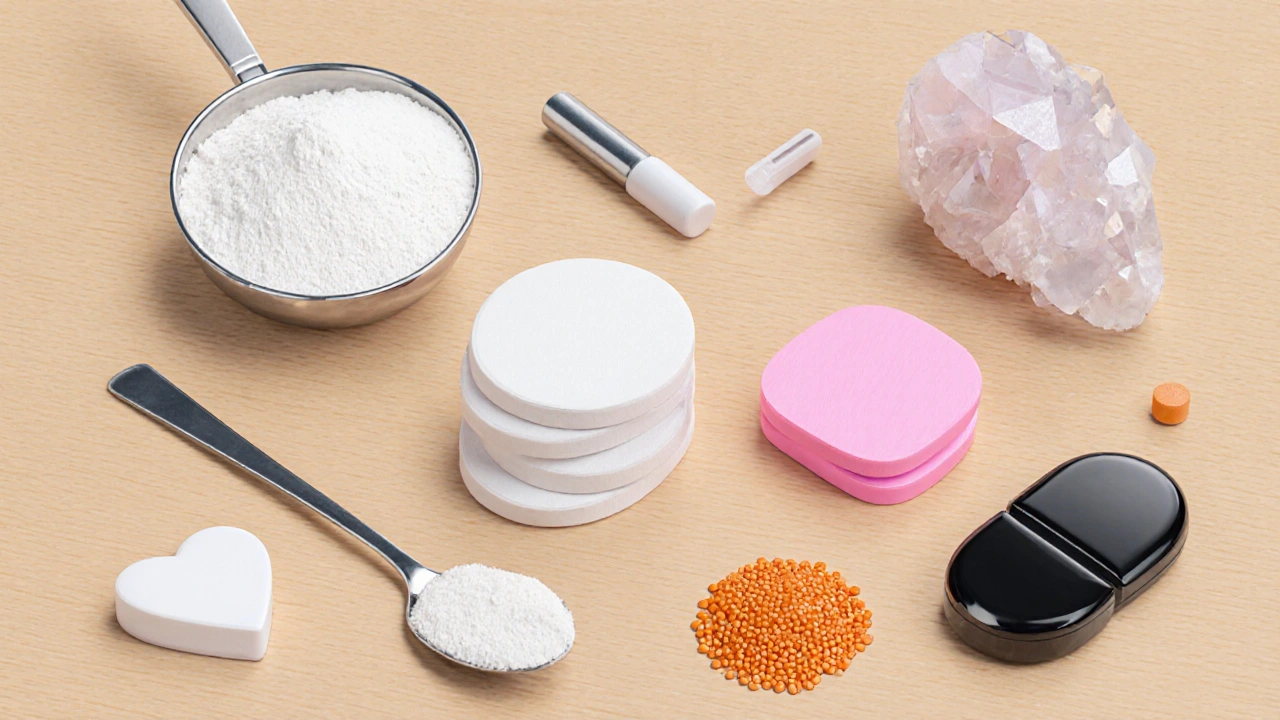Phosphate Binder Selector Tool
Recommended Binder:
Key Features:
Important Notes:
Patients with chronic kidney disease (CKD) often battle high phosphate levels, and the choice of a phosphate binder can feel overwhelming. Renagel is a brand name for sevelamer, a non‑calcium phosphate binder that works by binding dietary phosphate in the gut. It’s popular, but several other options exist, each with its own strengths and drawbacks. This guide breaks down the most common alternatives, compares key attributes, and helps you decide which binder fits your health goals and lifestyle.
Key Takeaways
- Sevelamer (Renagel) removes phosphate without adding calcium, making it ideal for patients at risk of vascular calcification.
- Lanthanum carbonate provides strong phosphate control with a low pill burden but can cause GI irritation.
- Calcium‑based binders (acetate, carbonate) are inexpensive but raise calcium load, which may not suit everyone.
- Ferric citrate and sucroferric oxyhydroxide are newer, iron‑based binders that also improve iron stores.
- Cost, side‑effects, and personal preferences (pill size, taste) are often the deciding factors.
What is Sevelamer (Renagel)?
Sevelamer is a polymeric amine that binds phosphate ions in the gastrointestinal tract, preventing absorption. It comes in two formulations: the original powder (Renagel) and the chewable tablet (Renvela). Because it contains no calcium or metal, it does not contribute to extra calcium load, which is crucial for patients with a history of vascular calcification or hypercalcemia. Typical dosing ranges from 800mg to 2400mg three times daily, adjusted to serum phosphate targets.
Why Phosphate Binders Matter in CKD
When kidneys can’t filter phosphate effectively, serum levels rise, leading to bone disease, itching, and accelerated cardiovascular calcification. A phosphate binder is a medication that binds dietary phosphate in the gut so it’s excreted in stool rather than absorbed. The goal is to keep serum phosphate within the recommended range (2.5-4.5mg/dL for most CKD patients) while avoiding excess calcium or metal accumulation.

Common Alternatives to Sevelamer
Below are the most frequently prescribed binders, each introduced with a brief definition.
Lanthanum carbonate is a chewable tablet that binds phosphate using the rare earth metal lanthanum. It’s known for its low pill burden (usually one‑to‑two tablets per meal) and minimal calcium contribution.
Calcium acetate supplies calcium while binding phosphate. It’s often the first‑line choice in dialysis patients because it’s inexpensive and also helps correct calcium deficits.
Calcium carbonate works similarly to acetate but contains more elemental calcium per tablet, which can be advantageous or risky depending on the patient’s calcium balance.
Ferric citrate is an iron‑based binder that not only reduces phosphate but also improves iron stores, potentially lowering the need for separate iron supplements.
Sucroferric oxyhydroxide (brand name: Velphoro) is a newer iron‑based polymer that offers a very low pill burden (often one tablet three times daily) and has a distinctive black‑gray appearance.
Side‑Effect Profiles at a Glance
- Sevelamer: GI upset, constipation, metallic taste; may lower LDL cholesterol.
- Lanthanum carbonate: Nausea, abdominal pain, rare accumulation of lanthanum in tissues (monitor in long‑term use).
- Calcium acetate / carbonate: Hypercalcemia, vascular calcification, constipation.
- Ferric citrate: Dark stools, nausea, potential iron overload in patients with high ferritin.
- Sucroferric oxyhydroxide: Black stools, mild GI discomfort, risk of iron overload if used long term without monitoring.
Comparative Table
| Binder | Mechanism | Typical Dose (per day) | Calcium Load | Common Side‑Effects | UK Cost Approx. | Best For |
|---|---|---|---|---|---|---|
| Sevelamer | Polymeric phosphate‑binding | 800mg-2400mg×3 | None | Constipation, metallic taste | £70‑£90 per month | Patients needing low calcium load |
| Lanthanum carbonate | Lanthanum‑phosphate complex | 500mg×3‑4 | None | Nausea, rare tissue accumulation | £55‑£75 per month | Low pill burden, calcium‑sensitive pts |
| Calcium acetate | Calcium‑phosphate complex | 667mg×3‑4 | High | Hypercalcemia, constipation | £5‑£10 per month | Cost‑conscious patients without calcium overload |
| Calcium carbonate | Calcium‑phosphate complex | 500mg×3‑4 | Very high | Hypercalcemia, constipation | £3‑£8 per month | Patients needing extra calcium supplementation |
| Ferric citrate | Iron‑phosphate complex | 800mg×3 | None | Dark stools, nausea, iron overload | £60‑£80 per month | Patients who also need iron supplementation |
| Sucroferric oxyhydroxide | Iron‑polymer binder | 250mg×3 | None | Black stools, mild GI upset | £65‑£85 per month | Patients preferring few pills |
How to Choose the Right Binder
Pick a binder by weighing three practical criteria:
- Calcium load management: If you have vascular calcification, avoid calcium‑based binders.
- Pill burden tolerance: Lanthanum and sucroferric oxyhydroxide need fewer tablets daily.
- Additional health needs: Iron‑based binders can double‑duty if you’re anemic.
Ask your nephrologist to review recent lab values (serum phosphate, calcium, ferritin) and any imaging that shows calcification. Then match those numbers to the binder profiles above.

Pros and Cons of Renagel Compared with Each Alternative
Renagel vs Lanthanum carbonate
- Pros of Renagel: No metal accumulation risk; modest cost difference.
- Cons of Renagel: Higher pill count (often 6‑9 tablets per day).
- Pros of Lanthanum: Low pill count, no calcium load.
- Cons of Lanthanum: Rare lanthanum deposition concerns in long‑term use.
Renagel vs Calcium acetate / carbonate
- Renagel avoids extra calcium, making it safer for patients with heart disease.
- Calcium binders are far cheaper, ideal when budget is tight and calcium levels are low.
Renagel vs Ferric citrate
- Both give phosphate control without calcium.
- Ferric citrate adds iron, which can reduce the need for separate iron supplements-but watch ferritin.
- Renagel may lower LDL cholesterol, a bonus for cardiovascular risk.
Renagel vs Sucroferric oxyhydroxide
- Sucroferric offers the smallest pill count (3 tablets per day) and similar calcium‑free profile.
- Renagel is more widely studied in older CKD cohorts and may be better tolerated in patients with sensitive GI tracts.
Practical Tips & Common Pitfalls
- Take with meals: All binders work best when taken during meals; missing a dose can spike phosphate.
- Watch for drug interactions: Sevelamer can bind other oral meds; separate them by at least 1hour.
- Monitor labs regularly: Serum phosphate, calcium, and ferritin should be checked every 1‑3months depending on the binder.
- Stay hydrated: Adequate fluid intake helps reduce constipation, especially with sevelamer.
- Be aware of stool color changes: Iron‑based binders turn stools black; this is harmless but worth informing patients.
Frequently Asked Questions
Can I switch from calcium acetate to Renagel without a washout period?
Yes. Most clinicians simply stop the calcium binder and start sevelamer at the recommended dose. Because there’s no overlap in active ingredients, a washout isn’t needed, but keep an eye on serum calcium for the first week.
Is sevelamer safe for patients on peritoneal dialysis?
Sevelamer is frequently used in peritoneal dialysis because it doesn’t add calcium, which can accumulate in the peritoneal membrane. Dosing may be slightly higher due to slower phosphate removal, so follow your nephrologist’s guidance.
How does ferric citrate affect iron studies?
Ferric citrate can raise ferritin and transferrin saturation, sometimes eliminating the need for separate iron supplements. However, excessive iron buildup can be harmful, so labs should be reviewed every 2‑3months.
Why does sucroferric oxyhydroxide make stools black?
The iron particles aren’t fully absorbed, so they color the stool. The change is harmless, but patients should be told to avoid alarm and to report any additional GI bleeding.
Which binder is best for a patient with low blood pressure?
Low blood pressure isn’t directly affected by binders, but calcium‑based options can cause mild hypotension with large calcium loads. A non‑calcium binder like sevelamer or lanthanum is usually a safer bet.
Next Steps
1. Review your latest labs (phosphate, calcium, ferritin, lipid panel).
2. List any existing GI issues or pill‑size concerns.
3. Discuss the comparison table with your kidney care team - they can help you weigh cost versus benefit for your specific health profile.
4. If you decide on a switch, set a reminder to take the new binder with every main meal and track any side‑effects for the first month.
Choosing the right phosphate binder isn’t a one‑size‑fits‑all decision. By understanding how Sevelamer stacks up against lanthanum, calcium, and iron‑based alternatives, you can make a smarter, more personalized choice that supports both kidney health and overall wellbeing.

Christian Andrabado
October 5, 2025 AT 17:23Renagel is a solid option for many CKD patients but the pill count can be brutal.
Holly Hayes
October 6, 2025 AT 21:10If you’re caring about your heart you should dodge any calcium binder it’s just irresponsible.
Penn Shade
October 8, 2025 AT 00:56From a pharmacodynamic standpoint sevelamer binds phosphate without adding calcium which directly addresses the vascular calcification risk you mentioned. The polymeric structure also incidentally reduces LDL cholesterol in some cohorts, a side‑effect that can be beneficial for cardiovascular health. However the trade‑off is a higher tablet burden, often six to nine pills daily, which can affect adherence. Patients with gastrointestinal sensitivity should be monitored for constipation and a metallic taste. Drug‑drug interactions are also a concern; sevelamer can chelate other oral medications so spacing doses by an hour is recommended. Overall the risk‑benefit profile favors sevelamer for patients with high calcium load or existing heart disease.
Jennifer Banash
October 9, 2025 AT 04:43While the clinical data for sevelamer are robust, one must not overlook the economic implications. The monthly cost in the UK hovers around £70‑£90, which may be prohibitive for some patients. Furthermore, the necessity of multiple daily doses can erode quality of life, especially for elderly individuals with dexterity issues. In contrast, calcium acetate offers a fraction of the price and a simple dosing schedule, though at the expense of calcium overload. Physicians should therefore individualize therapy, balancing pharmacologic efficacy with patient‑centred considerations.
Stephen Gachie
October 10, 2025 AT 08:30When evaluating phosphate binders, one must adopt a holistic perspective that transcends mere biochemical parameters. Sevelamer, as a polymeric amine, operates by electrostatic attraction, sequestering phosphate ions within the gastrointestinal lumen. This mechanism inherently avoids the introduction of exogenous calcium, thereby mitigating the cascade of vascular calcification that plagues many CKD cohorts. Moreover, the ancillary lipid‑lowering effect, albeit modest, contributes to a favorable cardiovascular risk profile. Yet, the drug is not without drawbacks. The pill burden-typically six to nine tablets daily-can be an adherence deterrent, especially for patients already navigating complex medication regimens. Gastrointestinal side effects such as constipation and a metallic aftertaste further complicate its tolerability. From a pharmacoeconomic standpoint, the cost differential between sevelamer and calcium‑based binders is substantial; this may limit accessibility in resource‑constrained settings. Comparatively, lanthanum carbonate offers a low pill burden and negligible calcium load but raises concerns about rare tissue accumulation of lanthanum over prolonged use. Calcium acetate and carbonate remain cost‑effective, yet their propensity to elevate serum calcium necessitates vigilant monitoring in patients with pre‑existing cardiovascular disease. Iron‑based binders, such as ferric citrate and sucroferric oxyhydroxide, present an intriguing dual‑benefit by addressing both phosphate control and iron deficiency, albeit with the caveat of altered stool coloration and potential iron overload. Ultimately, the selection of a phosphate binder should be individualized, incorporating laboratory data, comorbid conditions, patient preferences, and socioeconomic factors. Regular reassessment is paramount, as the therapeutic landscape evolves with emerging evidence and novel formulations.
Sara Spitzer
October 11, 2025 AT 12:16Factual note: iron‑based binders do turn stools black – not a sign of bleeding. Also, sevelamer may lower LDL but the effect is modest.
Chester Bennett
October 12, 2025 AT 16:03Great points above. For anyone on a tight budget, calcium acetate remains a viable starter, but keep an eye on calcium trends.
Emma French
October 13, 2025 AT 19:50Remember to check your ferritin when on ferric citrate; iron overload is real.
Debra Cine
October 14, 2025 AT 23:36👍 Sevelamer works well for heart‑safe patients, but the pill burden can be a nightmare. 😅
Rajinder Singh
October 16, 2025 AT 03:23Indeed, the drama of swallowing ten tablets at each meal rivals any tragic Shakespearean climax – yet it saves lives.
anshu vijaywergiya
October 17, 2025 AT 07:10For newcomers, start with a calcium‑free binder if you have any vascular calcification risk – it’s safer.
William Goodwin
October 18, 2025 AT 10:56While the science behind phosphate binders is straightforward – they prevent absorption of dietary phosphate – the patient experience varies dramatically. 🌍 In many cultures, the sheer number of tablets required for sevelamer can be a cultural barrier, especially where pill‑splitting is frowned upon. 🌐 Iron‑based binders such as sucroferric oxyhydroxide, with their low pill burden, resonate better with patients who value simplicity. 🌏 However, the dark stool side‑effect can cause alarm in communities unfamiliar with the phenomenon, leading to unnecessary endoscopies. 🌎 Philosophically, we must ask whether we are treating a lab value or the whole person; a binder that aligns with a patient’s lifestyle may improve adherence more than one that is marginally more effective biochemically. 🌍 From a healthcare economics viewpoint, the cumulative cost of non‑adherence can outweigh the price difference between binders, a fact often missed in guideline tables. 🌐 Ultimately, shared decision‑making that incorporates cultural, economic, and personal preferences will yield the best long‑term outcomes for CKD patients worldwide.
Isha Bansal
October 19, 2025 AT 14:43It is patently obvious that any discourse which fails to address the nationalist implications of foreign pharmaceutical dependency is fundamentally flawed; sevelamer, being manufactured predominantly overseas, represents a subtle yet significant erosion of domestic drug sovereignty and therefore must be scrutinized through the lens of economic patriotism.
Ken Elelegwu
October 20, 2025 AT 18:30The elegance of sevelamer lies in its chemistry – a polymeric amine that sidesteps calcium altogether – a subtle triumph of pharmaceutical design that many overlook in favour of cheaper, less sophisticated options.
jenni williams
October 21, 2025 AT 22:16Hey there! 🌸 It’s awesome you’re digging into the binder options. Just remember to keep an eye on your labs and trust your doc – you’ve got this!
Kevin Galligan
October 23, 2025 AT 02:03Wow, another pill count debate – because we clearly needed more drama in our lives 😂. At least the binders do their job.
Marilyn Decalo
October 24, 2025 AT 05:50Honestly, the whole “sevelamer is better because it’s calcium‑free” narrative is overhyped; many patients tolerate calcium acetate just fine.
Mary Louise Leonardo
October 25, 2025 AT 09:36They don’t tell you that the pharma giants are hiding the truth about binder side‑effects – the black stools are a sign of a larger conspiracy to keep us on cheap meds!
Alex Bennett
October 26, 2025 AT 12:23Philosophically speaking, a binder is merely a tool; the real art lies in tailoring it to the patient’s unique physiology while keeping the tone light and professional.
Mica Massenburg
October 27, 2025 AT 16:10just keep an eye on your labs.